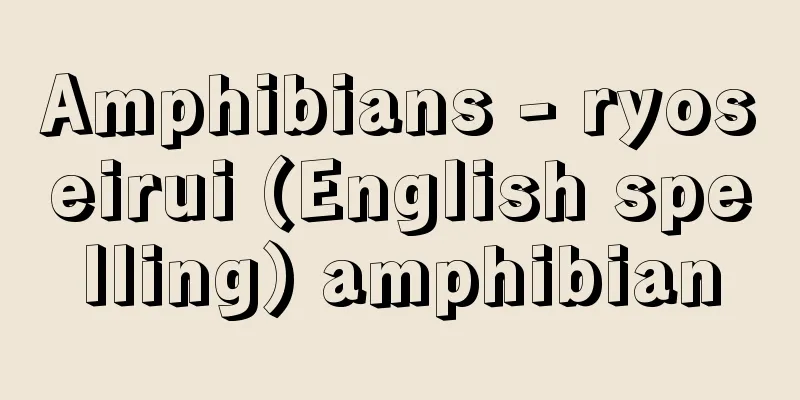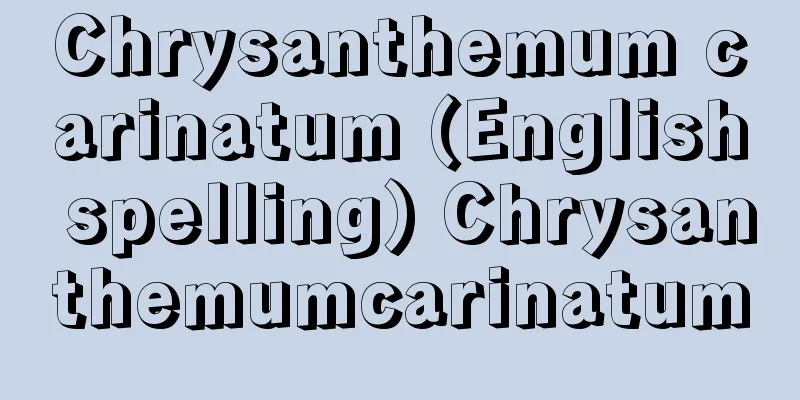Amphibians - ryoseirui (English spelling) amphibian

|
Animals belonging to the phylum Vertebrata and class Amphibia. These include frogs, salamanders (including newts), and caecilians. [Mitsuru Kuramoto] Lineage and morphologyAmphibians are the first vertebrates to live on land, and play an important role in evolutionary history as the group of animals that developed into reptiles, birds, and mammals. Amphibians originated from the bony fishes called Lophophorus, and the oldest amphibian, Ichthyostega , was discovered in strata from the Devonian period of the Paleozoic era. Lophophorus had strong, muscular paired fins that became the limbs of amphibians. Their swim bladders also became lungs, allowing them to breathe air on land instead of through gills. In the Carboniferous period, many different groups emerged, some of which were large, measuring over three meters in length, but in the Mesozoic era, reptiles developed and amphibians declined. Modern amphibians include three orders and about 3,400 species, making them the smallest class of vertebrates. Modern amphibians are relatively small, with the surface of their bodies covered in skin rich in secretory glands and lacking scales or hair. Their heads are flat and composed of fewer bones than fish. They are attached to the vertebrae by two occipital processes. Their brains lack a neocortex and their cerebrum is small. They have 10 pairs of cranial nerves, fewer than the 12 pairs found in reptiles. They have one ear bone. They lack a secondary palate. They have limbs on their torso, but these are degenerate in some urodele and absent in apodidae. They lack a diaphragm. Their hearts have two atria and one ventricle, and the separation of systemic and pulmonary circulation is incomplete. Their red blood cells are oval and nucleated. Their lung structure is simple, and some species lack lungs. They are cold-blooded. [Mitsuru Kuramoto] Distribution and ecologyThey are found all over the world except Antarctica and most of the Arctic. Except for introduced species, they do not live on ocean islands. Because their body surface is easily permeable to water, they mainly live in moist places and have a variety of lifestyles, including terrestrial, subterranean, arboreal, and aquatic. There are no species that live in saltwater. In principle, they eat small animals. Their eggs are small and surrounded by a layer of jelly, and have no eggshell. No embryonic membranes are formed. They generally lay eggs in water, and when the embryos hatch, they become larvae with gills that live in the water and metamorphose into adults. The morphology of the larvae differs in many ways from that of adults. In addition to this typical life cycle, there are species that lay eggs in moist areas on the ground or in trees, and in species that undergo internal fertilization, the embryos develop inside the mother's body and are born as larvae or juveniles that have completed metamorphosis. [Mitsuru Kuramoto] "The Life of Amphibians" by Fraser, translated by Takashi Yamagiwa (1976, Kyoritsu Shuppan)" ▽ "Colored Amphibians and Reptiles" edited by Shoichi Sengoku (1979, Ie no Hikari Kyokai)" ▽ "Colored Illustrated Guide to Japanese Amphibians and Reptiles by Kenji Nakamura and Shunichi Ueno (1963, Hoikusha)" Source: Shogakukan Encyclopedia Nipponica About Encyclopedia Nipponica Information | Legend |
|
脊椎(せきつい)動物門両生綱に属する動物。カエル、サンショウウオ(イモリを含む)、アシナシイモリ類が含まれる。 [倉本 満] 系統・形態脊椎動物で最初に陸上生活を始め、爬虫(はちゅう)類さらに鳥類、哺乳(ほにゅう)類へと発展する基礎となった動物群として、進化史で重要な位置を占める。両生類は硬骨魚類の総鰭(そうき)類に由来し、最古の両生類イクチオステガIchthyostegaは古生代デボン紀の地層に発見されている。総鰭類は筋肉質のじょうぶな対鰭をもち、これが両生類の四肢となった。また、うきぶくろが肺となり、えらにかわって陸上で空気呼吸を行うようになった。石炭紀には多様なグループを生じ、なかには全長3メートルを超す大形種もいたが、中生代になると爬虫類が発展して両生類は衰退した。現生の両生類は3目約3400種を含み、脊椎動物で最小の綱である。 現生の両生類は比較的小形で、体表は分泌腺(せん)に富む皮膚に覆われ、鱗(うろこ)や毛はない。頭は平たく、魚類より少ない骨で構成される。椎骨とは2個の後頭突起で接合する。脳に新皮質はなく、大脳は小さい。脳神経は10対で爬虫類の12対より少ない。耳骨は1個。二次口蓋(こうがい)はない。胴部に四肢があるが、有尾類の一部では退化し、無足類では欠如している。横隔膜はない。心臓は2心房1心室で、体循環と肺循環の分離は不完全。赤血球は楕円(だえん)形で有核である。肺の構造は簡単で、肺を欠く種もある。変温性。 [倉本 満] 分布・生態南極大陸と北極圏の大部分を除く全世界に分布する。移入種を除き、洋島にはいない。体表が水を透過しやすいため、主として湿った場所で生活し、地上性、地中性、樹上性、水中性など、さまざまな生活様式がある。海水にすむ種はいない。原則として小形動物を食べる。卵は小形でゼリー層に包まれ、卵殻はない。胚膜(はいまく)も形成されない。一般に水中に産卵し、孵化(ふか)した胚はえらを備えた幼生となって水中生活を送り、変態して成体となる。幼生の形態は多くの点で成体と異なる。この典型的な生活史のほか、湿った地上や樹上に産卵するものがあり、体内受精をする種では胚が母体内で発育して幼生または変態を終了した幼体となって産まれるものもある。 [倉本 満] 『フレーザー著、山極隆訳『両生類の生活』(1976・共立出版)』▽『千石正一編『原色両生・爬虫類』(1979・家の光協会)』▽『中村健児・上野俊一著『原色日本両生爬虫類図鑑』(1963・保育社)』 出典 小学館 日本大百科全書(ニッポニカ)日本大百科全書(ニッポニカ)について 情報 | 凡例 |
<<: Ryoseki Flora - Ryoseki Flora
Recommend
Polish movies - Polish movies
Film production in Poland began in 1902 when a you...
Abu Dhaf - Abu Dhaf
…His main interest was the holy sites and the pil...
Jadeite (English spelling)
A type of alkali pyroxene. The chemical compositio...
Nobushige Hozumi
Year of death: April 7, 1926 Year of birth: 11th J...
Radiation biology
This is a science that seeks to elucidate the phe...
Gloxinia speciosa (English spelling) Gloxinia speciosa
…Gloxinia refers to a group of horticultural vari...
"Onin Ryakki"
…He selected Enkyokushu, Enkyokusho, Shinkyokusho...
disaccommodation
…Ferrite is also used as a high-permeability mate...
Great auk (English spelling: Pinguinus impennis; great auk
Charadriiformes, Aukletidae. Extinct species (→ ex...
NSC (Occupational Safety)
…The safety movement among capitalists began in t...
buffalo-weaver
…This family is a relatively well-organized group...
Bing Crosby
American pop singer and actor. Born Harry Lillis ...
Andronicus, L. (English spelling) AndronicusL
...In the following, we will look back historical...
Jean Giraudoux
1882‐1944 French novelist, playwright, and diploma...
Ducula
...On the other hand, some species were once abun...









